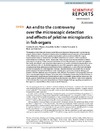Identificador persistente para citar o vincular este elemento:
https://accedacris.ulpgc.es/jspui/handle/10553/73936
| Título: | An end to the controversy over the microscopic detection and effects of pristine microplastics in fish organs | Autores/as: | De Sales-Ribeiro, Carolina Brito Casillas, Yeray Fernández Rodríguez, Antonio Jesús Caballero Cansino, María José |
Clasificación UNESCO: | 3105 Peces y fauna silvestre 330811 Control de la contaminación del agua |
Palabras clave: | Microscopic detection Pristine microplastics Fish organs |
Fecha de publicación: | 2020 | Publicación seriada: | Scientific Reports | Resumen: | The aquatic environment and the associated fish assemblages are being exposed to an increasing amount of microplastics. Despite the high number of publications on the presence of microplastics in fish, little is known about their uptake, translocation and accumulation within fish organs. Experimental studies on the detection and effects of pristine microplastics in fish have shown controversial and ambiguous results, respectively. Here, we conducted two experiments to detect and assess the impacts of dietary exposure of Danio rerio to different types of pristine microplastics. Our results show that D. rerio recognizes plastic particles as inedible materials but ingests them when mixed with food or fish oil. Accidental ingestion occurs in fish exposed to relatively small (1–5 µm) microplastic particles without associated food or fish oil. Additionally, D. rerio effectively eliminated pristine microplastics 24 h after ingestion; however, retention time was associated with increasing particle size and the intake of additional meals. Clinical signs, such as anorexia and lethargy, are present in fish fed relatively large microplastics (120–220 µm). The ingestion of microplastics does not induce any histopathological changes. To the best of our knowledge, we are able, for the first time, to fully demonstrate the uptake and translocation of plastic microbeads using confocal microscopy. Our results question the findings of previous studies on the detection and effects of pristine microplastics in fish and state that inaccurate interpretations of the histological findings regarding microplastics in fish organs is a prevalent flaw in the current scientific literature. | URI: | https://accedacris.ulpgc.es/handle/10553/73936 | ISSN: | 2045-2322 | DOI: | 10.1038/s41598-020-69062-3 | Fuente: | Scientific Reports [EISSN 2045-2322], v. 10 (1), Article number 12434, (Diciembre 2020) |
| Colección: | Artículos |
Citas SCOPUSTM
103
actualizado el 08-jun-2025
Citas de WEB OF SCIENCETM
Citations
94
actualizado el 08-jun-2025
Visitas
143
actualizado el 18-may-2024
Descargas
123
actualizado el 18-may-2024
Google ScholarTM
Verifica
Altmetric
Comparte
Exporta metadatos
Los elementos en ULPGC accedaCRIS están protegidos por derechos de autor con todos los derechos reservados, a menos que se indique lo contrario.
